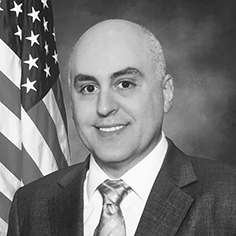Future Policing
International Keynote Session: Modernizing the police department with diversity and inclusion

Mark P. Smith
Inspector General
Los Angeles Police Commission

Civilian oversight
Police departments all around the world and particularly in North America have been under considerable pressure and scrutiny recently.
Police officers sometimes appear to be aloof or callous, whilst the department heads equally sometimes seem to be disconnected from the public that they are meant to be serving. Partly to combat that, following the riots in Los Angeles in the early 1990s, the Los Angeles Police Department (LAPD) set up the Los Angeles Police Commission and the Office of the Inspector General (OIG). Mark P. Smith , the current Inspector General of the Los Angeles Police Commission, says that as such, he is one of the “senior civilians” within the police force, but not the only one. In fact, “the head of the agency is a civilian Board of Police Commissioners – five civilians appointed by the Mayor of Los Angeles.” The Inspector-General reports to them, as does the Chief of Police. The Chief “runs operations for the 13,000 people within the LAPD on a daily basis,” but for any changes of policy, “the Chief has no authority to do that. Only the Police Commission has the authority to institute new policies or changes to policies.”
The OIG therefore has a critical role to play. It works to ensure “that all of our officers and employees act with honesty, dignity and respect toward the public.” This is underpinned by two principles or aphorisms: One is based on an ancient Roman saying of “who will watch the watchers, or in a more modern parlance, who will police the police?” By the nature of their work, the police have the “authority to deprive someone of their freedom or possibly their life.” But they are not above the law and thus “we’ve created some oversight so they can do their jobs professionally and within the bounds of the law.” The second one is that “the police are the people, and the people are the police.” This comes from “Sir Robert Peel a couple of centuries ago,” but is still relevant now. After all, law enforcement members are part of the community too, and the more “the relationship between those two is maintained, the more successful both will be.” So the OIG, therefore, is the “civilian oversight representation at the head of the LAPD.”
“Even if your programs are good, they’re working how you want them to work and crime is going down, if you’re not sharing what’s happening and being transparent with the public and civilians, you’re on the road to failure. This is true if all is working well and certainly if it’s not working well.”
Mark P. Smith, Inspector General, Los Angeles Police Commission

Overseeing technological and data-driven advances
This oversight manifests regularly, but was particularly relevant “a couple of years ago when the Police Commission was tasked with looking at the data-driven policing and technology platforms to inform how policing was being done.”
This is all about “how policing is going to leverage our technology and data to be as effective as we can be in addressing crime,” and how to prioritize police’s limited resources. In many ways, this was not a new issue. For years “the LAPD has been using data and technology.” The issue now was that there seemed to be “a substantial lack of transparency and that the technology was impacting specific communities in terms of over-policing.” Unsurprisingly, the over-policing was being felt in black or other minority neighborhoods. This stemmed from the fact that “the public did not have a sense of what kinds of software the LAPD was using, and what data was being shared. It was causing a lot of consternation and upheaval in the community.” In fact, it made headlines across LA for weeks, with the gist of them being that “predictive policing was being used to monitor specific people and neighborhoods.” Not only were there headlines and heated social media posts, but public meetings of the Commission were being disrupted and people were angry.
In the meantime, the civilian Police Commission asked the OIG to prepare a “substantial report, which is now available publicly.”
[1]
The independent nature of the OIG allowed them to find that “the various programs, technologies and data-driven programs that the LAPD was using were frankly being done quite unevenly across the department.” The process was “haphazard and with a lack of careful controls.” However, “we were unable to draw any reasonable or certain conclusions.” In essence, all the programs under investigation that were using technology were “helping the police to address crime in a more forward-thinking way,” but we’re also “having a negative impact on various segments of the community.”
The OIG, therefore, proposed a number of recommendations. First and foremost was that “if the department was going to continue to use technology to inform its policing, they need to carefully constrain and oversee the programs that they’re using.” Without that, the police can’t expect to “engender trust amongst the public.” Furthermore, “we also recommended that there be an independent evaluation of the efficacy and impact of these programs. You need someone from the outside.” This will also determine if there are any “unintended consequences.” The last two recommendations were that the LAPD needs to “obtain public feedback on programs that they are going to use,” and that “any data or findings need to be public and transparent.” These two are particularly important because “the public has to have a seat at the table,” and the police will be “doomed to failure if they haven’t brought in the public to allow civilians to have a voice in what they’re doing.”
[1] ‘Review of Selected Los Angeles Police Department Data-Driven Policing Strategies’ 2019, https://a27e0481-a3d0-44b8-8142-1376cfbb6e32.filesusr.com/ugd/b2dd23_21f6fe20f1b84c179abf440d4c049219.pdf
Apart from the technologies that the LAPD has been using, there are always new technologies coming through like “facial recognition technology, something widespread and widely used like body-worn cameras or even something beyond. The key is to ensure that the public is on board because otherwise your success as a law enforcement agency will be doomed to fail.”






















